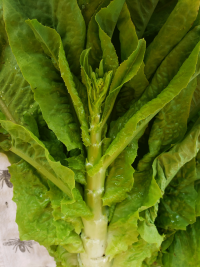
UC Davis Student Plant Breeders Cultivating Improved Varieties of Asian Celtuce
Celtuce is a stem lettuce most liked for its crisp and tender stalks
Researchers at UC Davis are working to develop new and improved varieties of celtuce, a leafy green vegetable that plays an important role in Asian cuisine. The Student Collaborative Organic Plant Breeding Education (SCOPE) project, which works with local organic growers on improving crop varieties, is analyzing the traits of celtuce to improve seed availability for small scale farmers.
Celtuce is often referred to as a stem lettuce. It’s grown mostly for its crunchy stalk, which has a mild and nutty taste, and can be served raw in salads, pickled or cooked in stir-fries. The plant’s leaves are edible too, though it tastes more bitter than other lettuce varieties.
Antonia Palkovic and Laura Roser, both specialists with SCOPE, say celtuce plants usually thrive in cool climates, so this project aims to develop a breeding line that would be better suited to grow in a hot, dry climate. This past winter, researchers crossed about a half dozen varieties of celtuce with head lettuce. They have a small plot at the Ecological Garden near the Student Farm and about 20-30 plants growing in a greenhouse.
Roser said that celtuce tends to bolt, or elongate, faster than other types of lettuce. When the plant bolts, the stems should be harvested soon to avoid a “woody” texture and bitter taste.
“We want to make sure that these varieties take a few weeks longer to bolt.” Roser said. “If we can extend the length of time it takes for them to bolt, that means there’s a few more weeks for farmers to harvest.”
Crops and culture
“One of the biggest things about this project that’s different than other SCOPE projects, is the cultural significance of this crop,” Roser said.
Celtuce is a popular crop in China. That’s where most of the seeds are from, and only a few varieties are available locally. Celtuce can also be tough to find in major grocery stores, but is usually available at Chinese or Asian markets, where it’s called woju or wosun.

Roser and Palkovic said several students and interns involved with the project are of Asian descent and they are excited to bring a crop to campus that has been a part of their family heritage.
“It’s great to see them feel included and supported as they realize they have special cultural expertise in this crop,” Palkovic said. “It really ties well to the Student Farm’s mission of being inclusive of all different groups of people.”
The project, funded in part by the UC Davis Public Impact Research Initiative, is a collaborative effort between SCOPE, the Student Farm, Department of Asian American Studies and local farmers, including Kristyn Leach, who operates the two-acre Namu Farm in Winters. Leach grows mostly traditional Korean and Asian crops, including soybeans, peppers and perilla (an edible plant used as an herb). She says unlike other crops, like tomatoes, farmers in the region have limited options when it comes to celtuce seed. She’s hopeful this project will not only produce more celtuce varieties, but also raise awareness about Asian crops.
“I’m excited that we can collect and share in-depth information about growing celtuce and appreciate the botanical aspects of it, as well as increase the understanding of the crop and share that with farmers,” Leach said.
Ga Young Chung, assistant professor with Asian American studies, is proud to be collaborating on this project by exploring the connections between crops and culture. By highlighting the role Asian American communities have played in food and agriculture, Chung hopes this project will lead to greater diversity for breeding programs.
Later this fall, the group plans to send seed to local farmers to grow the celtuce varieties and provide feedback to the breeders about which selections grow well and taste good. They’re also looking for chefs and grocers to give pointers on what traits are important from a culinary perspective.
“Hopefully our program can serve as a model that can easily be expanded to other farmers, other crops, and higher education institutions, especially since it is suited for farming communities underserved by major commercial breeding programs,” Chung said.
Media Resources
Antonia Palkovic, SCOPE Project, antoniapalkovic@gmail.com
Laura Roser, SCOPE Project, lcroser@ucdavis.edu
Ga Young Chung, Asian American Studies, gachung@ucdavis.edu
Tiffany Dobbyn, College of Agricultural and Environmental Sciences, tadobbyn@ucdavis.edu